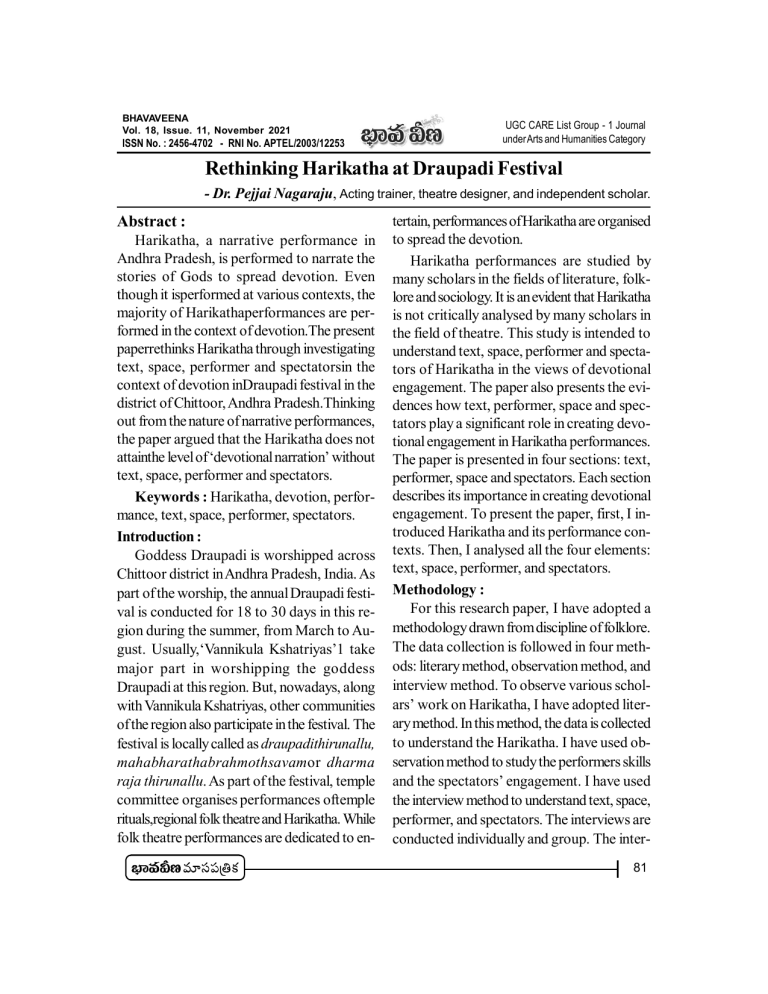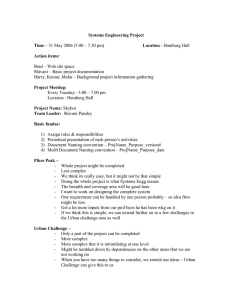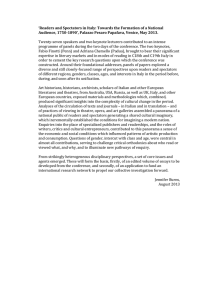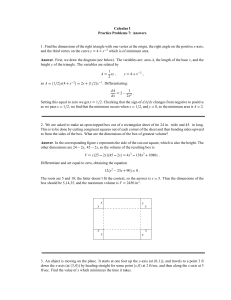
BHAVAVEENA Vol. 18, Issue. 11, November 2021 ISSN No. : 2456-4702 - RNI No. APTEL/2003/12253 UGC CARE List Group - 1 Journal under Arts and Humanities Category Rethinking Harikatha at Draupadi Festival - Dr. Pejjai Nagaraju, Acting trainer, theatre designer, and independent scholar. Abstract : Harikatha, a narrative performance in Andhra Pradesh, is performed to narrate the stories of Gods to spread devotion. Even though it isperformed at various contexts, the majority of Harikathaperformances are performed in the context of devotion.The present paperrethinks Harikatha through investigating text, space, performer and spectatorsin the context of devotion inDraupadi festival in the district of Chittoor, Andhra Pradesh.Thinking out from the nature of narrative performances, the paper argued that the Harikatha does not attainthe level of ‘devotional narration’ without text, space, performer and spectators. Keywords : Harikatha, devotion, performance, text, space, performer, spectators. Introduction : Goddess Draupadi is worshipped across Chittoor district in Andhra Pradesh, India. As part of the worship, the annual Draupadi festival is conducted for 18 to 30 days in this region during the summer, from March to August. Usually,‘Vannikula Kshatriyas’1 take major part in worshipping the goddess Draupadi at this region. But, nowadays, along with Vannikula Kshatriyas, other communities of the region also participate in the festival. The festival is locally called as draupadithirunallu, mahabharathabrahmothsavamor dharma raja thirunallu. As part of the festival, temple committee organises performances oftemple rituals,regional folk theatre and Harikatha. While folk theatre performances are dedicated to en- tertain, performances of Harikatha are organised to spread the devotion. Harikatha performances are studied by many scholars in the fields of literature, folklore and sociology. It is an evident that Harikatha is not critically analysed by many scholars in the field of theatre. This study is intended to understand text, space, performer and spectators of Harikatha in the views of devotional engagement. The paper also presents the evidences how text, performer, space and spectators play a significant role in creating devotional engagement in Harikatha performances. The paper is presented in four sections: text, performer, space and spectators. Each section describes its importance in creating devotional engagement. To present the paper, first, I introduced Harikatha and its performance contexts. Then, I analysed all the four elements: text, space, performer, and spectators. Methodology : For this research paper, I have adopted a methodology drawn from discipline of folklore. The data collection is followed in four methods: literary method, observation method, and interview method. To observe various scholars’ work on Harikatha, I have adopted literary method. In this method, the data is collected to understand the Harikatha. I have used observation method to study the performers skills and the spectators’ engagement. I have used the interview method to understand text, space, performer, and spectators. The interviews are conducted individually and group. The inter81 BHAVAVEENA Vol. 18, Issue. 11, November 2021 ISSN No. : 2456-4702 - RNI No. APTEL/2003/12253 views are done in both structured and nonstructured. Harikatha and its performance contexts: In India, many narrative forms are available, and some of them are performed by a solo performer. Harikatha is one of these solo narrative forms. Evidences suggests that Harikatha is performed for centuries in various regions in India: Tamil Nadu, Telangana, Andra Pradesh, Karnataka, and Maharastra. Harikatha is adapted regional languages in its performances. Various scholars refers this narrative form with various names: “Harikathakalakhepam, Hari Keerthanam, Harikatha ganam, Samkeerthanam, Sathkathakalakshepam, SathkaDhagaana, Sangeethopanyasam, Akshaganam, Yakshaganam, Geyaprabhandam, kalakhepam, katha, Kathaprasangam, Katha gaanam, and Kathakalapkekam”. But, for Telugu speakers, the narrative from is known as Harikatha, Harikatha Kathanam, and Katha Kaalakhepam. The performance text of Harikatha is usually taken from puranas (the sacred test to teach wisdom) and epics. Harikatha performances are an amalgam of “music, song, and piety literature”. Harikatha is usually organisedon the occasion of celebration at auspicious days in Hindu calendar. It is also performed on the occasions of marriage, death ceremony, auspicious day, birth ceremony, wedding, birth celebration, death anniversary, meritorious act, vow and feast. Along with these contexts, Harikatha is also performed in the context of Draupadi festival. At the Draupadi festival, Harikatha is called as called as ‘Pagati Katha’(Pagati means day and kathameans story). Local com- UGC CARE List Group - 1 Journal under Arts and Humanities Category munities believe that Harikatha is performed to purify the premises and to keep the devotees’ sins away.At Draupadi festival, Harikatha is patronised by villagers that host the festival. In this festival, Harikatha is organised for 18 days, and each day is dedicated to narrate a Parva from Mahabharatha. A Parva is planned to narrate more than three hours. Usually, Harikatha is performed between 2pm and 6pm at Draupadi festival. These performances are intended to transmit devotion on Pandavas. Scholars also establishes that Harikatha performances are organised at Draupadi festivals since ages. For instance, Julia Hollander observes the relationship between Draupadi festival and the storytelling form (136); she writes: “Hiltebeitel dates the storytelling tradition in Draupadi Amman temples to circa AD 600– 700”; she also refers Hiltebeitel’s argument as “the present practice of using a Classical Tamil text by Villiputurar for the storytelling sessions probably goes back to the fourteenth century”.3 Thus, Harikatha establishes relationship with Draupadi festivals for manycenturies. Text : The performance text of Harikatha is derived from various themes. The evidences prove that Harikatha text is initially created based on the Hindu religious themes. Later, the text has been written to entertain, educate, impose patriotism, and spread religion. The evidences also prove that performance text of Harikatha is also written to spread Christianity and Islam. For instance, Donappaobserves Harikatha text is written to spread religions of Christianity and Islam (207-214). Thus, performance text of Harikatha is written on multiple issues. When it is observed within Hindu religion, Harikatha text 82 BHAVAVEENA Vol. 18, Issue. 11, November 2021 ISSN No. : 2456-4702 - RNI No. APTEL/2003/12253 is written based on Ramayana, Mahabharatha and Puranic stories. In the context of Drauapadi festival, Harikatha text is derived from Mahabharathastories to spread devotion on Pandavas. Since the stories of Mahabharatha is available in classical and spoken Telugu language, narration of Harikatha is mixed with both styles of language. Since the translation of Mahabharatha in Telugu is no longer spoken, every line of classical text is translated by Haridasu into contemporary spoken Telugu language for spectators. Sincea Harikatha performances is longer than two hours, the performance text is incorporated with ‘humours stories and passages of holy text’ in-between the main plot. While the humorous stories attract spectators of various classes, passages of holy text are organised to engage the spectators devotionally. Generally, humorous stories are a resource of social commentary. But, the passages of holy text are purely drawn from epics and puranas.The holy passages are included with hymns, verses and poems. After reciting it, the meanings of the holy passages are illuminated to the spectators in local dialect. Thus, the main plot is incorporated with humorous stories, passages of holy text and hymns. The performances text of Harikatha is also included with pittakathalu(side stories). These short stories play a significant role to engage spectators devotionally in Harikatha. As they are containing humorous incidents, pittakathalu energise the spectators during the performance. pittakathalualso bring back the spectators from deep involvement of the story. For instance, somestories are based on a serious subject which make the spectators to be tired and UGC CARE List Group - 1 Journal under Arts and Humanities Category disturbed. In this case, the side stories dethatch the spectators from the main theme for some time. In some situations, pittakathaluis also narrated to elaborate a complex scene, incident, or situation of a story. The side stories are intended to educate the spectators with praising the good deeds and disrespecting the bad deeds of a character. Sitaramanjaneya observes that Harikatha adopts side stories to create humour. According to him “G. Balaji added English songs in his Telugu Harikatha performance, Parimi Subramanyam included a Telugu poetic text which resembles children’s speech and ChallaRamalingaiah replaced classical text with local dialect in songs.” (Sitaramanjaneya32-33).Majority of the side stories are purely meant to comment on existing social issues and the behaviour of humans.These evidences suggest that side stories indirectly remind the spectators engage with devotion. Along with the side stories, Harikahta text is included with hymns, songs and poetry that is to offer additional information to teach devotion and moral. Based on its occupation, Harikatha performance text can be divided into two major parts: stories and non-stories. In the part of the stories, Harikatha performance text contains main story and side stories. The part of non-stories is categorised with the hymns, songs, and poetry which may not demonstrate a direct relation with the main story, but it is purely intended to create the devotional environment. Based on its chronological order of performance, A performance text of Harikatha can be divided in three major sections: introduction, middle and conclusion. The introduction 83 BHAVAVEENA Vol. 18, Issue. 11, November 2021 ISSN No. : 2456-4702 - RNI No. APTEL/2003/12253 contains the songs for stage preliminaries, and it also introduces the story, performance context, and sponsors of the performance; it also acknowledges the spectators. The songs for stage preliminaries contain worshipping the god. Here, the songs are included with rituals such an offering camphor, flowers and homage. This section invokes devotional feeling in the spectators. In the middle section of Harikatha performance text, the main story is presented with verses, conversations, hymns, passages of holy text, songs, poetic text and side stories. In the conclusion section, namasankeerthanam4and a mangalam5songs are given in the text. These songs also include the rituals which is performed in the introduction section to invoke devotional feeling. Space : Harikatha performances do not demand well organised stage. It probably desires a raised platform to elevate the performer from the spectators. Usually, the performance space is decorated with flowers and mango leaves. In Draupadi festival, the performance space of Harikatha is temporarily erected in the temple hall. If it is not erected, the performance space is covered with a carpet to distinguish it from spectators’ space. While the centre of the performance space is dedicated for the narrator, both sides of the centre are offered for musicians. A Draupadi’s idol is placedbetween the performance space and the spectators’ space. In this performance space, flowers, mango leaves, and the Draupadi’s idol create a devotional environment. Spectators’ space is very large, and it accommodates more than 500 people. The spectators’ space is not lodged with chairs, but it is levelled to sit on the floor. Some UGC CARE List Group - 1 Journal under Arts and Humanities Category spectators sit on the mats which they bring from their home. When compare to the performance space, spectators’ space is not filled with devotional materials such as flowers, mango leaves or Draupadi idol. The spectators’ space just suggests the communal space. Performer : Harikatha is performed by a single performer, and it emphasises the role of the performer. The performer is good in singing, narrating, storytelling and acting. He demonstrates multiple character during the narration and storytelling. Performer of Harikatha is locally called as “Kathakudu, Katha-gana-parudu, Katha-gayakudu, Katha-prasangidasu, Bhagavatha-katha-prasangi, Bhagavathar, Bhagavathi, Bhagavathudu, Harikathaprasangi, Haridasu” (Donappa 1978, 112). The performer is popularly known as Haridasu, Bhagavathar or Bhavatharini. The male performer is called as Haridasu or Bhagavathar, and the female performer is referred as Bhavatharini. Usually, Harithakaperformer is considered a human being who serves the society and the god. The performer, Haridasu, does not wear any costumes that represents a character in the story. He wears costumes that communicates Lord Hari. Some performer just wear a Dhoti (“the original men’s wear in India”), and places a garland around his neck. As it represents for the messenger of god, the costumes traditionally guide the spectators to reach devotional level. Along with his costumes, Haridasu’s performance skills allow the spectators to invite the devotional feelings. He is good at speaking fluently, singing well, acting perfectly, and dancing rhythmically and guiding spectators 84 BHAVAVEENA Vol. 18, Issue. 11, November 2021 ISSN No. : 2456-4702 - RNI No. APTEL/2003/12253 philosophically.The performer always prospers in representing a huge collection of characters from the myths, epics, and contemporary stories. Donappa comments on Harikatha performer: “the performer role in Harikatha is equal to the narrator (Sutradhara) in traditional Indian theatre; the narrator leaves the stage after the introduction of the play, but in Harikatha the performer takes various roles until he finishes the performance” (101). Donappa’s comment supports to think that Harikatha performer enacts multiple characters along with the narrator in Harikatha. From a narrator, he can transform himself into Dhramaraja, Draupadi, Duryodhana or Arjuna with just a modification of movement, gesture or posture. This transformation to the divine characters allows the spectators to engage devotionally. The performer represents a character with voice and gestures. He also takes movement during the narration. His movements are observed various directions on the stage. He moves from upstage to downstage and left stage to right stage. He also takes few circular movements. The circular movements are visible in dancing for a song. The movements of the performer are accompanied by musical instruments. The performer plays Chidathaluwhile performing. Chidathalu and other musical instruments accompany the dialogues, poetic text, songs and the performer’s movements.It can be described that both music and the performers’ movements create devotional space. One of the performance skills of Haridasu is acting with an invisible character. Here, the performer creates invisible characters on the stage with his body language, and he interacts UGC CARE List Group - 1 Journal under Arts and Humanities Category with the invisible characters. The performer creates the illusion of another character standing beside of him. He communicates this process with narration, postures and mimic actions. For instance, in the scene where Duryodhana fights with Bheema, Haridasu portrays Duryodhana and created invisible character Bheema; After this action, Haridasu comes back to the role of narrator from the character of Duryodhana. Here, he narrates the characters positions. Now, he portrays Bheema. This cycle of switching the roles from a character to the narrator is common practice in Harikatha. Haridasu interaction with invisible character allows spectators to imagine more than one character on the stage. Harikatha performer needs to demonstrate voice skills as well. His first and important voice skill is to control the breath. If he does not control his breath, the performer cannot utilise his voice; the performer becomes hoarse; he may acquire abnormal voice during the performance (Donappa 106). Along with his voice skills, he has to be good at speech and diction. He is capable to deliver the speech in fast and slow without spoiling the clarity of the text. He can communicate the meaning of the text with different speeds of speaking. The performer reaches his maximum volume in case of a performance without a microphone. When he demonstrating evil characters, he may use loud voices. He is good to manipulate with his high and low pitch voices to deliver dialogues. He is capable to modulate the voice to express the mood of the scene. Since Harikatha is narrative form, his voice and speech are a major source for him to create images in the minds of spectators. Especially, his vocal skills and el85 BHAVAVEENA Vol. 18, Issue. 11, November 2021 ISSN No. : 2456-4702 - RNI No. APTEL/2003/12253 egance of speech creates a space for spectators to experience devotion. During the performance, the performer pauses the narration for few reasons. At these pauses, he recites special text. This is not part of the main plot. The special text is locally known as Echcharikala6. It is one- or two-lines phrases meant to recite by spectators along with the performer. It is recited between the intervals of the performance. These intervals are caused with many reasons: when spectators are emotionally and physically tired; when spectators are distracted; when performer forgets the text; and when spectators offer homage to the performer. In these cases, the performer recites the special text: Echcharikala. Echcharikala is a tool to energise the spectators. It leads the spectators to follow the story. It attracts towards the story from any kind of distractions. It is spoken by the Haridasu and recited by spectators. It is performed irrespective of the story. Donappa has observed few Echcharikala: “Sri Anjaneya varadagovindohari, Sri P u n d a re e k a v a r a d a g o v i n d o h a r i , Sri madi n daraaramanag ovi n do ha ri , srimadramaaramanagovindohari” (61). The primary aim of Echcharikala is devote Lord Hari. Since it is a most sacred word for the local community, govindainvites the spectators to engage with devotion. Namasankeerthanam functions exactly the same as Echcharikala in Harikatha. Along with these functions, Namasankeerthanam is possibly utilised to bring back the spectators from the fictional world. The word Namasankeertha- UGC CARE List Group - 1 Journal under Arts and Humanities Category nam is also referred as Namayagnam, Namavali and Divyanamasankeerhtana (Donappa 130). Nama is a common word in all these words. Nama, the Telugu word, is referred as mind. Sankeerthanam means a combination of hymns. Thus, Namasankeerthanam probably expresses the actions of certain hymns to lead the mind towards devotion. Similar meaning is observable to the word Namayagnam. In this word, Yagnam means sacrifice. By adding both words Nama and Yagnam, Namayagnam possibly refers the meaning of sacrifice of mind. This notion of Namayagnam also invites devotional engagement . Donappas has noted 24 Namasankeerthanams in his book Telugu Harikatha Sarvasvam (131-132). Based on the performance text, the performer selectsa few of Namasankeerthanams. Donappa says Namasankeerthanams are also performed at the end of the performance, before the mangalam (a song at the conclusion of the performance). Thus, Namasankeerthanams is performed to build a connection between the spectators and the performance during the interruptions of the narration. Spectators : According to Ransome, storytelling concept rooted back to the oral tradition where elders were narrating cautious examples to the children and their family members (6). Ransome illustration on the origin of storytelling is appropriate to compare with the origin of Indian storytelling, because the ancient Indian story telling was focused on themes of Dharma (ethics and the code of conduct of the individuals). Thus, Harikatha may have reasons to emphasis Dharma inside stories of Harikatha. It is obvious that the Harikatha is also performed 86 BHAVAVEENA Vol. 18, Issue. 11, November 2021 ISSN No. : 2456-4702 - RNI No. APTEL/2003/12253 to educate the people and to teach intellectuality. Consequently, most of the spectators come to watch Harikatha performance to devote and to explore Dharma. Harikatha has been surviving in the context of devotion, and it has also demonstrated human values through its performances. The local community believes that listening Harikatha makes them to identify their souls with the god (probably with Lord Hari). According to Nagarathnam, listening Harikatah is actual rest, to eradicate all troubles, Moksham, mukthi (salvation). According to a devotee, listening Harikatha purifies one’s mind and keeps him/ her away from the bad thoughts. People also believe that listening Harikatha make one to submit himself to Lord Hari. As they are watching for several years, most of the spectators are familiar with the philosophical subjects that are embedded in Harikatha performance text. The spectators must demonstrate basic knowledge at Indian epics and myths to follow entire performance. Some spectators, who are not aware of the Indian epics and myths, are engaged with side stories. Even these side stories entertain, it gives moral messages at the end of the narration of the side story. Spectators do not expect any double-meaning narration in Harikatha. In Harikatha, spectators seemingly focus on the spiritual expression in the text. In her paper, Harikatha: New Message through an old Form, Usharani Narayana notes H K Ranganath’s comment on Harikatha as, “it (Harikatha) was indeed the right school of the illiterate masses in the villages and educated them on dramatic episodes contained in human classic like Ramayana and Mahabharatha”7. Donappaobserves that the word Hari destroys UGC CARE List Group - 1 Journal under Arts and Humanities Category the sins. The meaning of the word Hari leads the spectators to believe that listening Harikatha destroys their (spectators’) sins. The belief allows the spectators who wish to destroy their sins to watch Harikatha, and it makes them to reach the devotional world from the real world. Thus, Harikatha educates spectators through devotional text, and drive the spectators to reach the devotional world. During the performance, spectators pay homage to the performer. The tradition of paying homage to the performer is locally called as Chadivimpulu. When a spectator pays an homage, spectators is blessed by the performer. Chadivimpuluis also paid to the performer to request the god to release the sole of a loved person who is already dead. The homage is paid in the form of cash, blouse piece, flowers, fruits and sweets. Most of the times, spectators pay homage in the form of cash. When Draupadi-vastrapaharanamu is narrated by a female narrator, some female spectators offer blouse piece, fruits, flowers, vermilion, turmeric powder, betel leaves and areca nuts to the narrator. Usually the local community believe that the materials offer to Draupadi are sacred. Thus, paying homage devotionally engages the spectators. At the end of the performance, spectators are requested to pay dhakshina(“an offering made in money”). The request is made sending harathiplate to the spectators. Before harathiplate is sent to the spectators, the performer offers money in the harathiplate and recites Hari Namasmarana. Then spectators follow to offer money in the plate. Then, the performer performsmanagalam.Here, along with emotional participation, physical partici87 BHAVAVEENA Vol. 18, Issue. 11, November 2021 ISSN No. : 2456-4702 - RNI No. APTEL/2003/12253 pation of the spectators is observed when they perform Chadivimpuluand dhakshina. This physical participation suggests the spectators to call as active participants in the performance. The activities of Chadivimpuluand dhakshinais believed that spectators are offering the gift to the gods. This evidence also suggests to observe the spectators’ devotional engagement. Conclusion : By revisiting text, space, performer and spectators, I have reconstructed aspects of devotion in the performance of Harikatha. This study establishes the relation between devo- UGC CARE List Group - 1 Journal under Arts and Humanities Category tional environment and the role of various elements of Harikatha. The study also proved that devotional engagement of spectators is influenced by text, space, performer and spectator of Harikatha. In this paper, I have also presented how Mahabaratha stories are narrated to spread the devotion on Pandavas. Even it is a narrative performance, Harikatha can be studied with theatre aspects such as text, space, performer and spectator. The adaptation of theatre aspects for this study supported to throw more light on devotional engagement of the spectators. Bibliography : 1. Donappa, Thoomati. Telugu Harikatha Sarvaswam. Hyderabad: Telugu Academy, 1978. Print. 2. Gurumurthy, Premeela. Kathaakaalakshepa (musical Discourse): A Study. Chennai: U of Madras Publications, 2009. Print. 3. Hiltebeitel, Alf. The Cult of Draupadi. Vol. 1. Chicago and London: U of Chicago, 1988. Print. 4. Hiltebeitel, Alf. The Cult of Draupadi. Vol. 2. Chicago and London: U of Chicago, 1991. Print. 5. Hollander, Julia. Indian Folk Theatres. London: Routledge, 2007. Print. 6. Rani, N. U.. “Harikatha : new message through an old form.” (1991). 7. Ransome, Arthur. A History of Story-telling: Studies in the Development of Narrative. London: T.C. & E.C. Jack, 1909. Print. also available at https:// ia 8 0 0 3 0 4 . u s . a r c h iv e . o r g / 2 7 / it e ms / h i s t o r yo fs t o r yt e 0 0 r a n s u o ft / historyofstoryte00ransuoft.pdf 8. Sitaramanjaneya, Vaadarevu, Bhagavathar. Andhra Harikatha Vangmayamu. Nellore: Kamalambika, 1976. Print. Funded by Andhra Pradesh Sahitya Akademi. 9. Thurston, Edgar, and Kandur Rangachari. Castes and Tribes of Southern India. Vol. 4. Madras: Government, 1909. Print. K to M. 88





